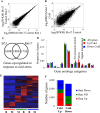Authentic Research Experience and "Big Data" Analysis in the Classroom: Maize Response to Abiotic Stress
- PMID: 26163561
- PMCID: PMC4710385
- DOI: 10.1187/cbe.15-04-0081
Authentic Research Experience and "Big Data" Analysis in the Classroom: Maize Response to Abiotic Stress
Abstract
Integration of inquiry-based approaches into curriculum is transforming the way science is taught and studied in undergraduate classrooms. Incorporating quantitative reasoning and mathematical skills into authentic biology undergraduate research projects has been shown to benefit students in developing various skills necessary for future scientists and to attract students to science, technology, engineering, and mathematics disciplines. While large-scale data analysis became an essential part of modern biological research, students have few opportunities to engage in analysis of large biological data sets. RNA-seq analysis, a tool that allows precise measurement of the level of gene expression for all genes in a genome, revolutionized molecular biology and provides ample opportunities for engaging students in authentic research. We developed, implemented, and assessed a series of authentic research laboratory exercises incorporating a large data RNA-seq analysis into an introductory undergraduate classroom. Our laboratory series is focused on analyzing gene expression changes in response to abiotic stress in maize seedlings; however, it could be easily adapted to the analysis of any other biological system with available RNA-seq data. Objective and subjective assessment of student learning demonstrated gains in understanding important biological concepts and in skills related to the process of science.
© 2015 I. Makarevitch et al. CBE—Life Sciences Education © 2015 The American Society for Cell Biology. This article is distributed by The American Society for Cell Biology under license from the author(s). It is available to the public under an Attribution–Noncommercial–Share Alike 3.0 Unported Creative Commons License (http://creativecommons.org/licenses/by-nc-sa/3.0).
Figures





Similar articles
-
A unique large-scale undergraduate research experience in molecular systems biology for non-mathematics majors.Biochem Mol Biol Educ. 2017 May;45(3):235-248. doi: 10.1002/bmb.21033. Epub 2016 Dec 28. Biochem Mol Biol Educ. 2017. PMID: 28032403
-
Authentic Inquiry through Modeling in Biology (AIM-Bio): An Introductory Laboratory Curriculum That Increases Undergraduates' Scientific Agency and Skills.CBE Life Sci Educ. 2018 Dec;17(4):ar63. doi: 10.1187/cbe.18-06-0090. CBE Life Sci Educ. 2018. PMID: 30496030 Free PMC article.
-
The python project: a unique model for extending research opportunities to undergraduate students.CBE Life Sci Educ. 2014 Winter;13(4):698-710. doi: 10.1187/cbe.14-05-0089. CBE Life Sci Educ. 2014. PMID: 25452492 Free PMC article.
-
Killing two birds with one stone: Model plant systems as a tool to teach the fundamental concepts of gene expression while analyzing biological data.Biochim Biophys Acta Gene Regul Mech. 2017 Jan;1860(1):166-173. doi: 10.1016/j.bbagrm.2016.04.012. Epub 2016 May 4. Biochim Biophys Acta Gene Regul Mech. 2017. PMID: 27155065 Review.
-
A survey of scholarly literature describing the field of bioinformatics education and bioinformatics educational research.CBE Life Sci Educ. 2014 Winter;13(4):607-23. doi: 10.1187/cbe.13-10-0193. CBE Life Sci Educ. 2014. PMID: 25452484 Free PMC article. Review.
Cited by
-
The Organismal Form and Function Lab-Course: A New CURE for a Lack of Authentic Research Experiences in Organismal Biology.Integr Org Biol. 2019 Aug 23;1(1):obz021. doi: 10.1093/iob/obz021. eCollection 2019. Integr Org Biol. 2019. PMID: 33791536 Free PMC article.
-
Technology as a tool in teaching quantitative biology at the secondary and undergraduate levels: a review.Lett Biomath. 2018;5(1):30-48. doi: 10.1080/23737867.2017.1413432. Epub 2017 Dec 26. Lett Biomath. 2018. PMID: 30474050 Free PMC article.
-
Big Data to the Bench: Transcriptome Analysis for Undergraduates.CBE Life Sci Educ. 2019 Jun;18(2):ar19. doi: 10.1187/cbe.18-08-0161. CBE Life Sci Educ. 2019. PMID: 31074696 Free PMC article.
-
How to Identify the Research Abilities That Instructors Anticipate Students Will Develop in a Biochemistry Course-Based Undergraduate Research Experience (CURE).CBE Life Sci Educ. 2018 Jun;17(2):es4. doi: 10.1187/cbe.17-12-0250. CBE Life Sci Educ. 2018. PMID: 29749847 Free PMC article.
-
Current Status and Implementation of Science Practices in Course-Based Undergraduate Research Experiences (CUREs): A Systematic Literature Review.CBE Life Sci Educ. 2022 Dec;21(4):ar83. doi: 10.1187/cbe.22-04-0069. CBE Life Sci Educ. 2022. PMID: 36318310 Free PMC article.
References
-
- American Association for the Advancement of Science. Vision and Change: A Call to Action. Washington, DC: 2011.
-
- Bialek W, Botstein D. Introductory science and mathematics education for 21st century biologists. Science. 2004;303:788–790. - PubMed
Publication types
MeSH terms
LinkOut - more resources
Full Text Sources
Other Literature Sources

